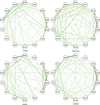The pathoplasticity of dysphoric episodes: differential impact of stressful life events on the pattern of depressive symptom inter-correlations
- PMID: 22093641
- PMCID: PMC3315770
- DOI: 10.1017/S003329171100211X
The pathoplasticity of dysphoric episodes: differential impact of stressful life events on the pattern of depressive symptom inter-correlations
Abstract
Background: Previous research has shown that stressful life events (SLEs) influence the pattern of individual depressive symptoms. However, we do not know how these differences arise. Two theories about the nature of psychiatric disorders have different predictions about the source of these differences: (1) SLEs influence depressive symptoms and correlations between them indirectly, via an underlying acute liability to develop a dysphoric episode (DE; common cause hypothesis); and (2) SLEs influence depressive symptoms and correlations between them directly (network hypothesis). The present study investigates the predictions of these two theories.
Method: We divided a population-based sample of 2096 Caucasian twins (49.9% female) who reported at least two aggregated depressive symptoms in the last year into four groups, based on the SLE they reported causing their symptoms. For these groups, we calculated tetrachoric correlations between the 14 disaggregated depressive symptoms and, subsequently, tested whether the resulting correlation patterns were significantly different and if those differences could be explained by underlying differences in a single acute liability to develop a DE.
Results: The four SLE groups had markedly different correlation patterns between the depressive symptoms. These differences were significant and could not be explained by underlying differences in the acute liability to develop a DE.
Conclusions: Our results are not compatible with the common cause perspective but are consistent with the predictions of the network hypothesis. We elaborate on the implications of a conceptual shift to the network perspective for our diagnostic and philosophical approach to the concept of what constitutes a psychiatric disorder.
Figures



References
-
- Birnbaum K. Der aufbau der Psychose. Berlin: Springer; 1923.
-
- Boccaletti S, Latora V, Moreno Y, Chavez M, Hwang D-U. Complex networks: structure and dynamics. Physics Reports. 2006;424:175–308.
-
- Bollen KA. Latent variables in psychology and the social sciences. Annual Review of Psychology. 2002;53:605–634. - PubMed
-
- Borsboom D, Mellenbergh GJ, van Heerden J. The theoretical status of latent variables. Psychological Review. 2003;110:203–219. - PubMed
-
- Brown GW, Bifulco A, Harris TO. Life events, vulnerability and onset of depression : some refinements. British Journal of Psychiatry. 1987;150:30–42. - PubMed
Publication types
MeSH terms
Grants and funding
LinkOut - more resources
Full Text Sources
Medical

